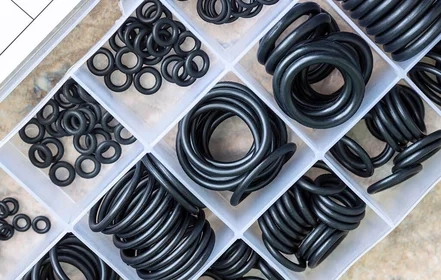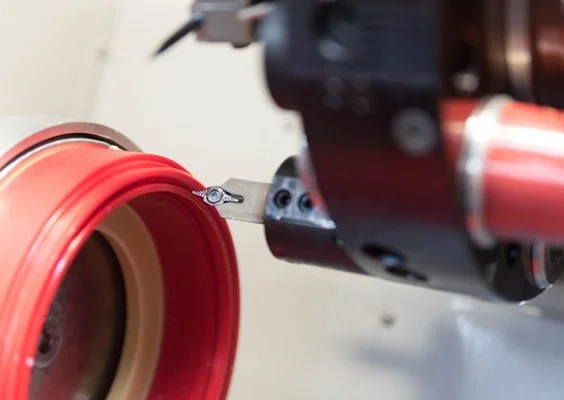-
Homepage
-
Sealing knowledge
- Guide - How do I find the right O-ring seal?
Guide - How do I find the right O-ring seal?
While O-ring seals are now indispensable in our daily lives, their history is not particularly long. The first patent for an O-ring was filed in Sweden at the end of the 19th century.
Generally, the Dane Niels Christensen is credited as the inventor - and his design is even more recent, dating back to 1936. Thanks to its versatile applicability, the design was quickly adopted and implemented across numerous fields.

Seals are components or structures that serve a crucial role in technical processes by preventing or limiting undesired transfers of substances from one location to another. Seals are omnipresent:
Sealing rings are as common in faucets as they are in vehicle tires or gas bottles. In commerce and industry too, the O-ring is indispensable. From small hand pumps to 40-ton mega presses, O-rings are installed and thus are perpetual companions in our daily lives, which is why it is crucial for them to perform their functions effectively.
It is essential to always consider factors such as dimensions, surface condition, and material properties, and to match these to the intended purpose. Even the highest quality seal will fail to perform adequately if it is made from inappropriate materials or if the dimensions are not suited to the application. Such failures can have costly consequences, as seals can significantly impact the lifespan of products as well as their operational safety.
What types of seals and gaskets are there?
Generally speaking, beyond the realm of poetic sealing, two types of seals are distinguished: dynamic and static seals.
Dynamic seals are applied wherever interacting surfaces move against each other. However, O-rings should only be utilized for slow-rotating motions in less critical areas. Due to its round cross-section, the O-ring is prone to rolling or twisting during lifting movements, which can lead to its rapid destruction. This is identifiable by a spiral crack in the defective O-ring.
Conversely, static seals are utilized where the interfaces are stationary, that is, in the static domain. In such cases, the O-ring (if necessary, with a backing ring) is certainly a favored option, alongside newer configurations like an O-ring support ring combination, exemplified by our DFL108.
O-ring seals in sealing technology can function both statically and dynamically. In static applications, they are notable for their ability to withstand very high pressures. Like all dynamic seals, dynamic O-rings cannot assure 100% tightness.
Yet, they approach complete tightness closely. And a certain level of permeability, known as "leakage", might actually be desirable — specifically when the minimally escaping substances conveniently serve as lubricants. Different application areas necessitate various types of O-ring seals.
To select the appropriate O-ring for your applications, it's crucial to understand the exact specifications required. These specifications include: - Inner diameter - Cross-sectional diameter - Material composition and characteristics (material) - Material hardness

In addition, it helps to consider the following points if you want to find the right seal:
Knowledge of applications and flange connections
An O-ring seal made from rubber or plastic may fail if the installation conditions are not proper. Dirty or rusty grooves, as well as sharp external edges, can damage the O-ring, rendering it unusable. The same holds true if the incorrect temperature is present.
Therefore, when selecting the appropriate O-ring seals for your application, it's vital to first familiarize yourself with the details of the material being used. Ensure that the characteristics of the planned environment match the requirements, including the corrosive properties of any fluids involved, the medium used, temperature levels, and operating pressure. After addressing these aspects, finding the suitable material for your O-ring seal becomes the next crucial step
Material Selection
Different O-ring seals are made of different materials. Elastomers are primarily used, which are suitable due to their dimensional stability.
Elastomers are very elastic, non-compressible, largely impermeable and have a large surface area. Its volume cannot be reduced even with deformation. In addition to elastomers, technical plastomers are also used.
For example, PTFE covers a completely different field than most elastomer O-rings due to its high resistance to various media and high temperature resistance in both the minus and plus range.
Metallic O-rings, on the other hand, naturally differ just by the choice of material. Due to the hardness and strength of the metal, they are particularly suitable at high pressure and high temperatures in the static range.

Get in touch with us!
We perform best under pressure! Personalized advice for the highest demands and a fast delivery guarantee ensure your satisfaction. Contact our sealing experts.
We look forward to your inquiry."
Testing of Chemical Resistance and Design
Before deciding on an O-ring made from a specific material, it's crucial to understand whether and to what degree that material is chemically resistant. For instance, while nitrile rubber (NBR) exhibits good oil resistance, it is not suitable for oxidizing liquids.
PTFE, on the other hand, is appropriate for the entire pH range from 0 to 14 but should not be used with media that contain molten alkalis or elemental fluorine. Furthermore, composite sealing rings are available, primarily used in the food industry and for medical purposes. They are the go-to option when any form of lubrication is unfeasible, or the environment is exceedingly sticky, and applications demand an extremely low initial or friction coefficient
Testing the performance of the O-ring seals
It is crucial to thoroughly test your chosen O-ring seals beforehand. This allows you to verify if the selected ring genuinely satisfies all the parameters of your application. Therefore, conducting various tests is recommended. These tests help ensure that the chosen O-rings encompass all quality-relevant characteristics.
Suitable tests include the hardness testing procedure, the compression set and cold flexibility tests, along with various swelling and aging tests. These tests can inform you whether the selected O-ring meets specific requirements related to pressure, medium, temperature, compression, or sealing capability. Additionally, individual quality assessments and ongoing series monitoring should be considered.
Search and find the right seal
Do you have questions or are you in search of the right seal? Are you looking for complete seal sets for your applications? Contact our experts in sealing solutions. We are eager to assist with your inquiries and find the appropriate solution for you! Further information can be found in our sealing knowledge section. Kofler - Dichtungen also offers hydraulic seals and pneumatic seals.
